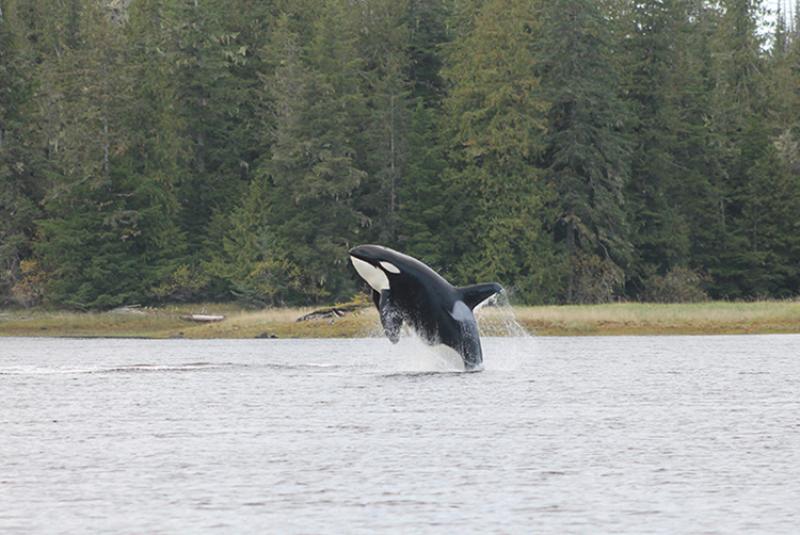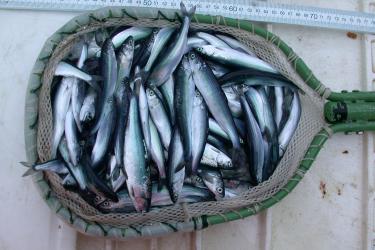Coffman Cove is a small, tightly knit community on Prince of Wales Island in Southeast Alaska. Many people both work and recreate on the waters in the area. In mid-August, two killer whales were observed in Barnes Lake. The unexpected sight was said to first appear as if jet skis were moving across the lake.
Community members reported the whales to NOAA’s Alaska 24-hour stranding hotline in late August. The lake has two natural channels to the ocean, and has significant tidal exchange with the ocean. Marine mammal experts hoped the whales would leave the lake on their own during the early September high tide cycle, but they did not. The lower high tides in early September and the large kelp bed in the north entrance of the lake may have been a barrier to their exit. It took a large team, and a lot of coordination, to finally coax the whales out of the lake.
This is not the first time killer whales have gotten trapped in Barnes Lake. In 1994, a group of offshore killer whales (an ecotype that feeds on sharks and other fish) was observed in this lake. Most were successfully herded back into the ocean with a boat-based intervention using oikomi pipes—hollow metal pipes people on boats hammer to create a loud noise. An effort using oikomi pipes requires multiple boats working in close coordination. David Bain with Orca Conservancy, who led the 1994 rescue, was onsite to participate in the recent response.
Using photos collected by Coffman Cove community members, Jared Towers with Fisheries and Oceans Canada and Bay Cetology identified the two killer whales as Bigg’s killer whales. Bigg’s killer whales eat marine mammals. Experts were concerned the whales likely had limited food resources while in the lake, meaning any intervention needed to happen quickly.
The large male is T051, a 42-year-old male who has been seen in British Columbia and Alaska. T049A2 is a 16-year-old male well known from the same waters. Prior to their appearance in Barnes Lake, T051 and T049A2 were last reported together off the west coast of Vancouver Island on July 9.
Planning a Response
NOAA Fisheries Alaska Region began coordinating a complex response to guide the two killer whales out of the lake and back to the ocean. The best opportunity for this operation was during the high tides between September 28 and October 2, when the channels into the lake were the deepest.
Team members from outside of Coffman Cove arrived on Prince of Wales Island September 24 and 25. The response team included two biologists with previous experience in killer whale entrapments, a graduate student studying Bigg’s killer whales, and NOAA’s Alaska Regional Stranding Coordinator.
They spent the first few days gathering or building the gear needed for the response.
On September 27, they collected images using a drone that showed both whales were in good body condition. The team also held a community meeting in Coffman Cove on Wednesday evening to explain the response plan and organize volunteers.
The team had three primary tactics to encourage the whales to depart the lake:
- Playbacks, or acoustic recordings, of whales known to travel with the Barnes Lake whales
- Hukilau, an ancient Hawaiian fishing method using lines and floats
- Oikomi pipes
The plan included the possibility of combining two or all three of the tactics.
Mandy Keogh, NOAA’s Alaska Regional Stranding Coordinator noted, “Barnes Lake was a really challenging area to mount a response. The tides dictated which day and how long we could work to encourage the whales out of the lake. Human safety is always the top priority in any stranding response and the local knowledge, boating skills, and dedication of the Coffman Cove community is what made this response possible.”
Employing Multiple Approaches
On September 28, the team of 14 boats and more than 30 Coffman Cove community members headed out to Barnes Lake, sequentially employing all three tactics. The two killer whales entered the channel on the north end on the falling tide. But, the kelp blocked their exit from the lake. Conditions were not favorable to try again that day.
The team returned September 29, this time with two parallel approaches. One team worked to remove some of the kelp from the north entrance to create a channel the whales could swim through. Meanwhile, a second team focused on moving the whales out of the lake through the south entrance.
“We started from the approach that worked in 1994, and adapted it to succeed with these two whales,” said David Bain of Orca Conservancy. “Barnes Lake is difficult to get in and out of, as the exits are narrow and shallow, whitewater forms when the current is strong, and much of both channels dry out and waterfalls form at low tide. Driving through the north channel as we did in 1994 didn't work this year, perhaps because the kelp was thicker and stronger, the tide wasn't quite as high, and the whales were larger. So, we decided to try to take advantage of these whales' greater willingness to move through shallow water and narrow passages and try the south channel.”
Using the playbacks of known whales, the team was able to draw both killer whales into the south channel. Once both whales entered the channel, the team deployed the hukilau and had several oikomi pipes ready for use if needed. This time the killer whales showed no hesitation and continued to swim through the channel. With the aid of the high tide, they were able to leave Barnes Lake.
“Using a series of brief recordings of females these two whales are known to enjoy traveling with, we managed to coax them into and through the exit channel. It sounds simple but in fact required a huge effort from dozens of people to successfully pull it off. It’s good to know that after more than 6 weeks in a small lake that they have their freedom back,” said Jared Towers, killer whale research technician from Fisheries and Oceans Canada.
“Their responsiveness to the playbacks allowed us to get them to the channel entrance at the right time (high slack); the hukilau was redesigned overnight by commercial fishers to allow it to be deployed quickly enough to discourage them from returning to the lake; and a last playback encouraged them to head for open water,” added Bain. “Then they just followed the boat out. They traveled more than 10 miles in the first 2 1/2 hours at sea, which gives us hope that we got them out while their condition was still good enough for them to survive."
“It was a very cool experience to have been involved in and I appreciated all of the work that NOAA did to facilitate making this happen!” said Coffman Cove resident Doug Rhodes.
This successful rescue response would not have been possible without the community of Coffman Cove including local citizens, fishing outfitters, sports fisherman, commercial fisherman, and local businesses who volunteered their time, boats, local knowledge, and hospitality.
“It was a wonderful team effort, composed of ideas contributed by local residents as well as those experienced working with whales,” said Bain.
Our partners include the community of Coffman Cove, Fisheries and Oceans Canada, and Orca Conservancy. We received additional help and information from:
- Alaska Department of Fish and Game
- U.S. Forest Service
- Washington Department of Fish and Wildlife
All response activities were authorized under the Marine Mammal Health and Stranding Response Program Permit 24359.
If you see a stranded, injured, entangled, or dead marine mammal, immediately call the NOAA Fisheries Alaska Statewide 24-hour Stranding Hotline at (877) 925-7773.








